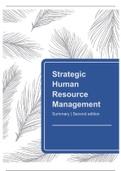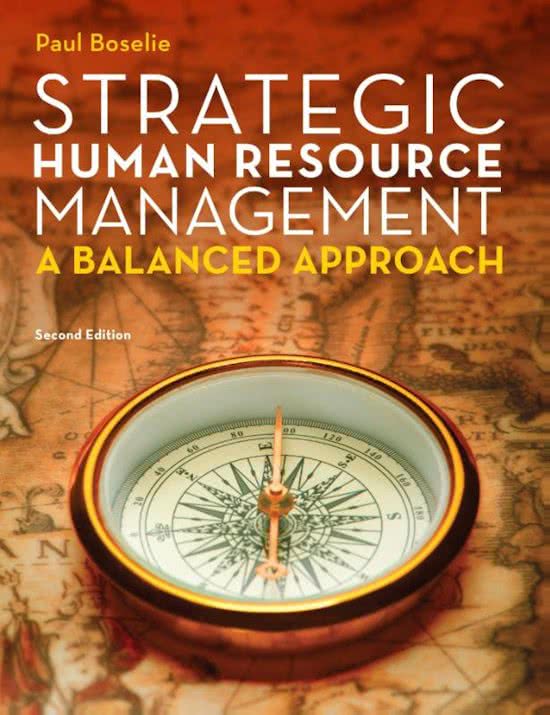Strategic
Human
Resource
Management
Summary | Second edition
,
,Chapter 1 – Introduction: SHRM in the Twenty-first Century
Overall, it is concluded in both theory and practice that employees matter and that the management of
employees – HRM – is a potential source for achieving organizational goals. Organizational change is
inevitable for most contemporary organizations. Mergers, acquisitions and reorganizations have become
common practices for most organizations, not just multinational companies (MNCs) but small and medium
enterprises (SMEs) and not-for-profit organizations as well. Organizational change almost automatically
affects one of the organization’s most valuable assets: employees. Successful organizational change highly
depends on changing people in their attitudes, behaviour and cognition. This asks for flexibility and good
people management.
The new economy
The 1990s introduced a new concept mainly focused on the shift from a manufacturing and production
economy into a service sector asset-based economy: the new economy. The old economy still exists in
developing countries and countries with relatively cheap labour conditions. Outsourcing and offshoring
business activities to developing countries are another characteristic of the new economy. In the new
economy assets are less tangible and are embedded in reputation, brands and knowledge of employees.
Organizational change has become a common practice in the new economy with major implications for
employees.
Organizational change and competitive advantage
HRM can be a source for gaining competitive advantage and supporting organizational change. Competitive
advantage represents an organization’s position in comparison to its direct competitors. Competitive
advantage tells us something about how well the organization is doing in comparison to others in the same
branch of industry or in the same region. ‘An organization with competitive advantage is doing better than its
competitors irrespective of the actual firm performance. In case of losses, the organization is still doing
better than its competitors. In case of profits, the organization makes more profits than the others.’
The changing role of work in modern organizations (p. 4)
The rise of the new economy in the 1990s created a shift from (traditional) production to services in most
Western societies. This shift has had a major impact on the nature of jobs in these societies. New flexible
work arrangements characterize modern organizations with benefits for both the employer and the
employee.
MHRM, IHRM and SHRM
HRM involves management decisions related to policies and practices that together shape the employment
relationship and are aimed at achieving individual, organizational and societal goals. SHRM builds on this
definition and in addition pays extra attention to the organizational context, reflected in special attention to
potential alignment of the business strategy and HRM, the alignment of the institutional context and HRM,
the linkage between business systems and HRM and the fit between HR practices. Boxall et al. state that
HRM is ‘the management of work and people towards desired ends.’ They identify three major sub-fields:
1. MHRM: sub-functions of HR policy and practice, including recruitment and selection, induction and
socialization, and training and development. Mainly focused on the shaping of the employment relationship
on the individual employee level and has strong roots in organizational behaviour and occupational
psychology.
2. IHRM: HRM in MNCs and HRM across borders. Focuses on e.g. transferability of HR practices across
business units in different countries, the optimal management of expatriates and the impact of different
institutional country contexts on HRM. Has a comparative nature.
3. SHRM: issues of linking HRM to the business strategy, designing high-performance work systems
(HPWSs) and adding value through good people management in an attempt to gain sustained competitive
advantage. The concept of ‘fit’ plays a central role within SHRM. It is mainly focused on the alignment
between HRM and the organizational internal and external context and has strong roots in strategic
management and organization studies.
Stakeholders of an organization represent all groups inside and outside an organization that can affect its
strategy and goals. Internal: employees, line managers, top management and employee representatives.
External: shareholders, financiers, trade unions, national government, local government and other interest
groups.
Three perspectives
The multidimensional strategic HR model in this book includes the following key characteristics:
1. A multi-actor perspective (multiple stakeholders including employees, managers, HR professionals,
works councils, trade unions, top management, shareholders, financiers and government);
2. A broad societal view with an emphasis on different institutional contexts;
, 3. A multi-level perspective including the individual employee perspective and the strategic organizational
perspective.
The multidimensional strategic HRM model is inspired by the European approaches to HRM and industrial
relations (IR). Paauwe’s view on HRM is as follows:
Human resources are something more than just ‘resources’;
HRM is not concerned solely with financial performance;
HRM focuses on the exchange relationship between employee and organization;
The shaping of the employment relationship takes place in an era of continuous tension between the
added value and moral values.
The employment relationship is the focus of HRM and can be characterized by the following four contract
elements: 1) legal contract, 2) economic/transactional contract, 3) psychological contract and 4) sociological
contract.
Tensions
HRM operates in an area of continuous tensions between added value and moral values. The added value
represents the economic side of organizing work and mainly represents the role of HRM in creating
economic value and increasing financial performance of an organization. The moral values reflect the notion
of employees as human beings with feelings, emotions, opinions, norms and values. ‘Hard’ HRM mainly
focuses on the economics and ‘soft’ HRM mainly focuses on the human side of organizing. Boxall and
Purcell argue that:
HRM covers all workforce groups, incl. core employees, peripheral employees and contingent workers;
HRM involves line and specialist managers, and is not solely aimed at employees;
HRM is all about managing work and people, collectively and individually;
HRM is embedded in industries and societies.
Traditionally, a distinction is made between the Anglo-Saxon or Anglo-American models and the
Rhineland models. The Anglo-American approaches in IR and HRM mainly focus on creating shareholder
value in terms of profits and market value with little or no attention to other stakeholders including trade
unions and work councils. The Rhineland models acknowledge multiple stakeholders and their interests
explicitly taking into account employee interests in terms of well-being and societal interests.
The balanced approach
In times of globalization and increased competition, there is a growing awareness that sustained competitive
advantage depends on balancing market demands and institutional pressures. In the strategic balance
model, organizational success can only be achieved when financial performance and societal performance
of an organization are above in the particular population in which the organization is operating. There is a
growing willingness among MNCs to look beyond financial results and take into account the interests of
multiple stakeholders. In public sectors the challenge is to rebalance the organization towards the economic
side of organizing without losing sight of their societal performance. The European Rhineland model and the
British IR approaches have a much richer tradition in stakeholder acknowledgement than the Anglo-
American model, mainly due to differences in institutional contexts. Coercive mechanisms (e.g. legislation,
formal position trade unions/work countries and CBAs) are stronger and more deeply embedded in Europe
than in the USA.
The definition of ‘good’ and ‘bad’ people management can be linked to the balanced approach. Taking into
account multiple stakeholder interests and a broader societal view in the design of the employment
relationship in an organization is likely to result in ‘good’ people management. Using a narrow and unitarist
perspective is likely to result in ‘bad’ people management.
The balanced approach blends economic and institutional interests in an attempt to create sustained
competitive advantage.
Framing HRM
Bolman and Deal present four different perspectives or frames for studying organizations. Applying different
frames (perspectives) can contribute to a better territory understanding and rapid cognition of organization
and HRM realities. The four frames are as follows:
1. Structural frame (factory/machine): seeks to gain understanding of various (structural) parts of an
organization. Very technical and functionalistic way of looking at organizational life. Central concepts in this
particular frame are rules, roles, goals, policies, technology and environment. This frame has strong links
with the strategic contingency approaches of the 1960s and 1970s.
2. HR frame (family): focuses upon the employment relationship. Represents a specific way of looking at
organizations mainly focused on concept e.g. needs, skills and relationships of those involved. Has strong
psychological background and profile.
3. Political frame (jungle): examines issues of power. Power, conflict, competition and organizational
politics are leading concepts. Heavy emphasis on the different parties.





